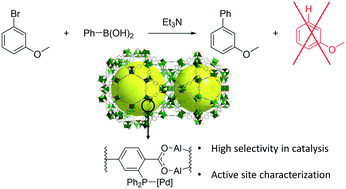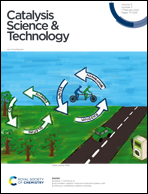Highly selective Suzuki reaction catalysed by a molecular Pd–P-MOF catalyst under mild conditions: role of ligands and palladium speciation†
Abstract
Cross-coupling reactions are a fundamental tool in the large scale synthesis of pharma-, agro- and fine chemicals. Homogeneous palladium complexes remain the state-of-the-art catalysts even though the use of heterogeneous palladium catalysts may have advantages such as catalyst recyclability, precious metal recovery and the possibility of being used in continuous flow operation. However, this is predicated on achieving acceptable process stability and selectivity levels without side reactions, such as e.g. hydrodehalogenation of aryl halides. We report a molecularly-defined heterogeneous palladium catalyst based on a phosphine-metal–organic framework (P-MOF) ligand system. This catalyst performed Suzuki reactions in exceptionally mild conditions while displaying a unique selectivity, higher than that achieved using Pd(PPh3)4, a standard homogeneous catalyst. The new palladium P-MOF catalyst was active for a wide range of substrates. Determination of the palladium speciation showed that molecularly-defined palladium–phosphine sites catalyse the Suzuki cross-coupling with very high selectivity, and that, when formed, palladium nanoparticles promote hydrodehalogenation. The fraction of molecularly defined palladium is maximized by having excess of phosphine ligand in the system.



 Please wait while we load your content...
Please wait while we load your content...